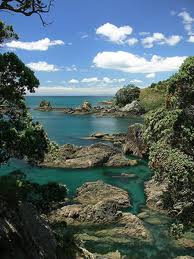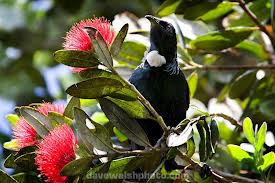Tiritiri Mitangi – Birding Adventure Down Under
Tiritiri Mitangi – Birding Adventure Down Under
By Linda Ballou
NABBW’s Adventure Travel Expert

December is a great time to explore the other land down under. The North Island of New Zealand is easy to get around and much less pricey than neighboring Australia. Kiwis take pride in making guests feel welcome and love to share their miles of hiking trails and un-trammeled shores. Tremendous efforts on the part of New Zealanders to preserve forests and the unique birds that call them home are especially evident on the tiny isle of Tiritiri Mitangi.
Spray splashed over the bow of our ferry chugging across the wind-tossed Hauraki Gulf to Tiritiri Mitangi. The white tower of the landmark lighthouse built in 1894 atop the island still gives warning to ships sailing into Auckland Harbor. It stands guard over remote Tiritiri, a 220-hectare, island habitat reclaimed by caring Kiwi\’s for rare, endemic birds.
 Like much of the North Island, Tiritiri was shaved clean of its forests for farming. For many years, the island was uninhabited save for the lighthouse keepers, and considered a useless, vermin infested, rock. Today, the island provides a unique opportunity for visitors to walk through native forests and hear the din of wild birds that proliferated before human contact, and serves as a monument to what caring people can do.
Like much of the North Island, Tiritiri was shaved clean of its forests for farming. For many years, the island was uninhabited save for the lighthouse keepers, and considered a useless, vermin infested, rock. Today, the island provides a unique opportunity for visitors to walk through native forests and hear the din of wild birds that proliferated before human contact, and serves as a monument to what caring people can do.
I boarded the ferry to Tiritiri in Gulf Harbor and joined a host of independent travelers who began their journey in Auckland. The colorful sails of yachts shared the channel with us as we plied our way up the Hibiscus Coast. The sun was high overhead in a brilliant blue sky when we tied up at wooden pier at Tiritiri. The swimmers and sunbathers aboard headed for the crystalline water of a nearby Hobbs Beach, a sandy cove beneath sea cliffs draped in morning glories, while birders made their way to the forests.
Miles of trails fan out over the island, encouraging guests to wander freely. Raised boardwalks beneath the cool of the native tree canopy make walking through the lovingly restored native bush a pure joy. Bird voices ring out in clear, lilting tones. It\’s easy to spot the source of the music because the wooden walk brings you to eye level of the tree canopy of the immature forest. Among the birds flitting in and out of the shadows are the Tui, or parson\’s bird. This black bird with the white tufts at his throat is a mimic and alternates between sweet tones that sound like that of the Bellbird (extinct on the North Island for more than 100 years, but surviving on Tiritiri) to hearty chortles and squawks with a fire and brimstone fervor.
 In this aviary without walls, birds gather at feeders lodged in cozy glens with seating platforms for visitors. I spotted the endangered Saddleback, a large black bird with a clamorous song that is enjoying a comeback here. The haunting voice of the increasingly rare and shy Kokako, a large gray parrot that cannot fly, drifted through the forest. The reclusive Stitchbird revealed itself, along with a chatty fantail that spread its\’ tail feathers for all to see. The rarest bird on the island is the Takahe, a giant flightless rail, thought to be extinct for 50 years. There are six breeding pairs nesting successfully here, raising their chicks in the wild.
In this aviary without walls, birds gather at feeders lodged in cozy glens with seating platforms for visitors. I spotted the endangered Saddleback, a large black bird with a clamorous song that is enjoying a comeback here. The haunting voice of the increasingly rare and shy Kokako, a large gray parrot that cannot fly, drifted through the forest. The reclusive Stitchbird revealed itself, along with a chatty fantail that spread its\’ tail feathers for all to see. The rarest bird on the island is the Takahe, a giant flightless rail, thought to be extinct for 50 years. There are six breeding pairs nesting successfully here, raising their chicks in the wild.
Since 1984, over two hundred thousand trees have been planted on the island by volunteer workers. Altogether, thirty-eight different trees and shrub, including cabbage trees, flax and wattle, provide seeds and berries for the birds. Restoration of the island has been a product of community effort. Service clubs, students, and outdoor recreation clubs provided free labor and donations. Together they exterminated a huge population of Pacific rat before the replanting of the island. They built hundreds of nesting boxes for the birds, including a special underground site for the nocturnal blue penguin. They made sure that stoats, weasels and possums that feast on bird\’s eggs and the tender shoots of sprouting trees do not exist here. These vermin, introduced to New Zealand\’s delicate ecology through trade and tourism, are the bane of the birds and native bush on the mainland.
After a picnic lunch, we made our way across the spine of the island to a valley where a primordial coastal forest has survived. These trees are the source of seeds for re-planting the island. Sun streamed through the sprays of immense silver ferns shading the walkway that took us past an ancient Pohutukawa tree with gnarled limbs that spread out in a tortured circle. This tree, flushed with a crown of crimson blooms, was here when the Maori people arrived on the island hundreds of years ago. It is believed that the early Polynesian setters cleared the island to plant fern beds for food. This mighty tree witnessed the destruction and the resurrection of the island ecology at the hand of humans. Today, the open sanctuary created for the birds on the island of Tititiri Matangi is free, with the price of a ferry ticket, for all to enjoy.
If You Go to Tiritiri Matangi off the North Island of New Zealand
Kiwi Wildlife Tours host guests at their home and take them to local birding hot spots, that include a visit to Tiritiri Matangi, as well as arrange tours through the North South and Stewart Islands with birding in mind. www.kiwi-wildlife.co.nz e-mail info@kiwi-wildlife.co.nz. Phone: +64 9 422 2115 Chris and Karen will pick you up at the Auckland Airport when you arrive.
Auckland Harbor ferries departing from Pier 3 next to the Ferry Building in Auckland provide transport to and from Tiritiri Matangi on Thursday and Sunday plus Saturday in summer. 0800-424-5561. Island conservation guides greet independent travelers at the pier with self-guiding maps
Linda Ballou says her mission is to experience as many beautiful places on our planet as she can, before they are no more. “Travel tales relating my experiences while kayaking, horseback riding, sailing, birding and hiking about the globe have appeared in numerous national magazines. I had a great deal of fun collecting travel stories, and profiles of people I have met in “naturally high places” for my newest book, Lost Angel Walkabout-One Traveler’s Tales. For a complete bio as well as published on-line clips with photos go to my website www.LindaBallouAuthor.com. Your reward, aside from learning about me and my work, will be to discover the secret to youth! Follow my blog to keep up with my latest adventures.”
 Linda's mission is to experience as many beautiful places on our planet as she can before they are no more. Travel tales relating her experiences while kayaking, horseback riding, sailing, birding and hiking about the globe have appeared in numerous national magazines. She had great fun collecting travel stories, and profiles of people she met in “naturally high places” for her book, Lost Angel Walkabout-One Traveler’s Tales. Her latest book Lost Angel Unleashed is the third book in her Lost Angel Trilogy
Linda's mission is to experience as many beautiful places on our planet as she can before they are no more. Travel tales relating her experiences while kayaking, horseback riding, sailing, birding and hiking about the globe have appeared in numerous national magazines. She had great fun collecting travel stories, and profiles of people she met in “naturally high places” for her book, Lost Angel Walkabout-One Traveler’s Tales. Her latest book Lost Angel Unleashed is the third book in her Lost Angel Trilogy 



